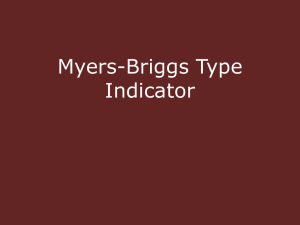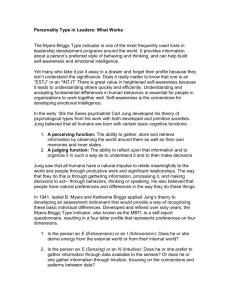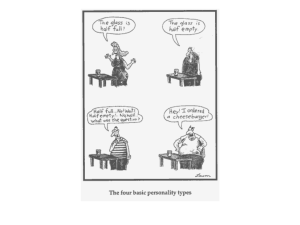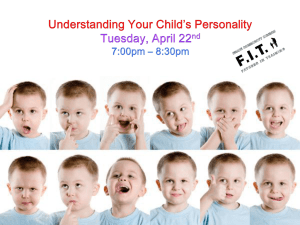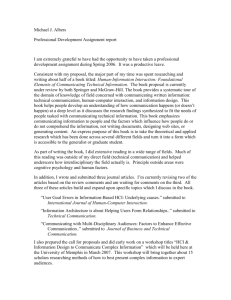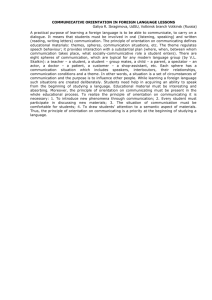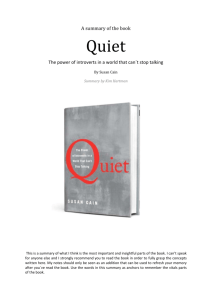Myers Briggs Type Indicator (MBTI)
advertisement
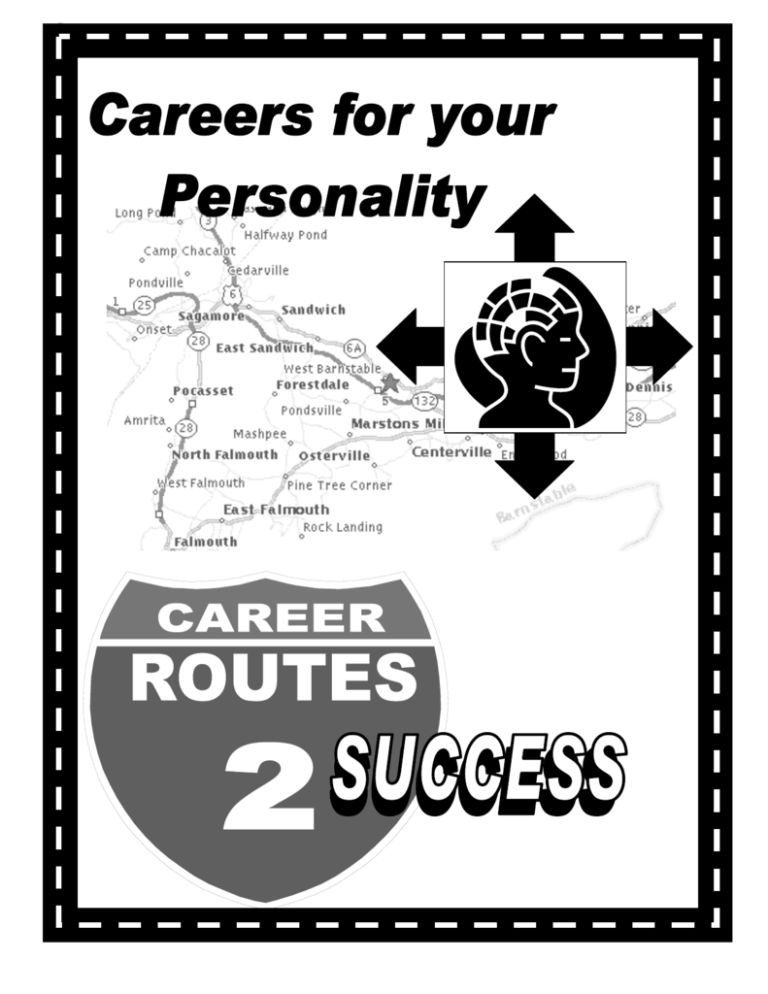
Myers Briggs Type Indicator (MBTI) Summary • The MBTI is a reliable and valid instrument that measures and categorizes your personality and behavior. It is not a test. There are no “right” or “wrong” answers. • Around 1940 a mother-daughter team (Katharine C. Briggs and her daughter Isabel Briggs Myers) developed this instrument to help people understand and use Carl Jung’s theory of psychological type preferences. • Swiss Psychologist, Carl Jung, (1875 – 1961) theorized that you can predict differences in people’s behavior if you know how they prefer to use their mind. According to Jung, we each have an inborn preference for using our mind in one of two different ways, in four different categories: Orientation to World Take in Information Make Decisions Extraverted Energized by others or Introverted Energized by ideas, emotions, memories Sensing Using five senses or Intuition Using gut or instincts Thinking Logical, problem solvers or Feeling Consider others, compassionate Take in Info. or Decide Perceiving Taking in information or Judging Organizing information and making decisions • There are a total of 16 possible “types” based on unique combinations of the preferences. • Four letters are used to represent a type, for example a person with preferences for Extraverted, Sensing, Thinking, Judging is called an ESTJ. • Each type has strengths and weaknesses. No type is better than another. • People can use this assessment tool to validate their preferences on each of the four dichotomies and understand the sixteen different personality types that result from the interactions among preferences. • Knowing your type can help you: choose a career that might be a good match for your personality understand others understand your own behavior communicate better with others work more cooperatively in groups with others manage people better in a work situation appreciate individual differences and more… Myers Briggs Type Indicator (MBTI) Self-“Guesstimate” Worksheet Which side do you think more accurately describes you? Write the letter in the box at the end of each pair. Orientation to the World Extraversion Focus on the outer world of people and things Receive energy from interacting with people Energized by taking action; active Prefer communicating by talking (over writing) Work out ideas by talking them through Learn best through sharing/doing/discussing Have broad interests Introversion Internal focus on ideas, memories, or emotion Receive energy from reflecting on thoughts Prefer communicating in writing (over talking) Learn best by having time alone to process Prefer working in quiet environments Able to focus on one project at length Known to be reflective, quiet, private, or deep My code: E or I Preference for Taking In Information (Perceiving) Sensing Focus on the present; what is happening now Prefer real/concrete/tangible information Attentive to details, specifics, and facts Enjoy tasks with an orderly, sequential format Like having five senses engaged while working Work at a steady pace and have stamina Known to be practical, steady, and orderly iNtuition Focus on future; possibilities and potential See the big picture, connections, or patterns Remember specifics when part of a pattern Imaginative and creative Bored by routine and sequential tasks Like solving problems and developing new skills Have bursts of energy rather than stamina S or N Preference for Making Decisions (Judging) Thinking Examine logical consequences of decisions Objectively weigh the pros and cons Base decisions on impersonal analysis and logic Energized by problem solving and critiquing Seek standard principles to apply uniformly Look for cause/effect relationships in data Consider feelings when presented as facts Feeling Base decisions on subjective values Enjoy appreciating and supporting others Actively look for qualities to praise in others Value and create harmonious environments Honor each person as a unique individual Assess impacts of decisions on others Work best in supportive, encouraging settings T or F Preference for Either Taking In Information or Making Decisions Judging Prefer to make decisions with information Make decisions as soon as possible Enjoy having closure; like things settled Plan and organize their world Like roles and expectations to be clear Enjoy getting things done/being productive Plan ahead to avoid last minute stresses Perceiving Prefer to take in information and understand Keep things open-ended as long as possible Seek to experience and live life; not control it Open to new options and last-minute changes Enjoy starting projects but often never finish Able to adapt; flexible Energized by last minute pressures J or P MBTI and Learning Styles and Strategies Extroverts (E) are energized by interaction with others. They are people of action. Es are pulled into social life and find it difficult to settle down, read, or concentrate on homework. They may find college tasks, such as reading, research, and writing challenging because they are solitary endeavors. They learn best by talking and physically engaging in the environment. Extroverts learn better in small classroom settings where students can actively engage in conversations with peers and professors as opposed to large lecture style classrooms where listening is the primary activity. Extroverts enjoy oral feedback from professors, as well as conversations before/after class or during office hours. Additionally, extraverts benefit from study groups where they can learn through speaking with others. Introverts (I) are energized by the inner world of reflection, thought, and contemplation. They need space and time alone. Introverts like reading, lectures, and written work. Therefore, they generally do well in traditional classroom settings. Introverts may hesitate to speak up in class but may benefit from one-onone conversations with a professor or written feedback. Online courses may work well for introverts as many often engage more in chat rooms or via email than contributing orally to a class discussion. Introverts may need time alone to reflect, process, and reenergize before joining a group or study group. Sensing (S) people rely heavily on their five senses to take in information. They may be good listeners or visually oriented learners. They also enjoy hands-on learning experiences. They like concrete facts, organization, and structure. They learn well from organized lectures or presentations. They are good at memorization. Sensing people usually like outlines, clear guidelines, and specifics. A syllabus is an important learning tool for Sensing types. As Sensing types often have difficulty with theory, they may struggle in classes where theoretical concepts are commonplace such as psychology or philosophy. Intuitive (N) people see the world through intuition. They learn by hunches. Intuitive students may not read a test question all the way through, sometimes missing a key part. Intuitive types want to know the theory before deciding that facts are important and will always ask "why". They are creative and innovative and may struggle following strict sets of instructions or on multiple choice tests. Ns also work with bursts of energy. Ns will write their term paper and then finish the required outline. Thinking (T) people decide on the basis of logic, analysis, and reason. They may be great at figuring out logical problems and analyzing problems. They may voice their strong opinions in the classroom. They expect fairness in grading, equal treatment of all students and adherence to fair classroom policies. Feeling (F) persons decide on the basis of their feelings, personal likes and dislikes. Feeling types value harmony and are distressed by interpersonal friction. Harmony in the classroom, with classmates and with the professor will be of ultimate importance for Feeling types. Judging (J) types try to order and control their world. They are decisive, may be closed-minded, and are usually well organized. They meet deadlines, like planning, and prefer to work on only one thing at a time. Judging types will usually have very well organized notebooks, and will structure their time to complete assignments promptly. Judging types will struggle if changes occur and they need to adapt, or if they are required to work with a group that is not as well organized, or if they need to cram for an exam. Perceiving (P) types are spontaneous and don't like to be boxed in by deadlines or plans. They want to gather more information before making a decision. They work at many things at once. Ps are flexible and often good in emergencies when plans are disrupted. Their biggest problem is procrastination. Ps may have trouble getting assignments in on time or budgeting their time. They may, however, actually do well cramming for an exam or rushing to get a project finished as they thrive on last-minute pressure. Communicating with MBTI Preferences When communicating with Extroverts Talk to them, preferably face to face Present information to extroverts in groups as they will like to talk about it with each other Emphasize the action to be taken Expect extroverts to toss ideas out and speak up in group situations When communicating with Introverts Put in writing – send an email instead of calling Present to them individually or in small groups Give them time to reflect on their thoughts after receiving information and before sharing their ideas with a group When communicating with Sensing Types Clearly present your topic in an orderly format Give lots of details, facts and concrete examples Use props, multimedia, or samples to help them see, hear, smell, touch, or taste your ideas Focus on the tangible, practical results that can be achieved in the short term When communicating with Intuitive Types (Ns) Discuss the big picture and long-term possibilities Emphasize ideas/concepts instead of details If you must mention specifics, do so using patterns and emphasize their connections Give them a problem to solve and allow them room to be innovative, novel and creative When communicating with Thinking Types Be brief – get to the point Use logical (not emotional) arguments to appeal to the head, not the heart Clearly identify any pros or cons to be weighed Allow them time to critique Expect them to be fair When communicating with Feeling Types Create a supportive, friendly environment Begin with words of appreciation and identify areas of agreement Use emotional arguments instead of logic and emphasize the effect on people involved Self-disclose with personal anecdotes or examples When communicating with Judging Types Be prompt (or early) and stick to a schedule Present information in an organized manner Emphasize deadlines and timetables Expect decisions to be made quickly Don’t include surprises When communicating with Perceiving Types Expect to have fun Leave extra time to actually get work done; a deadline will not really be perceived as the deadline Present information as options that are modifiable and let them draw conclusions Capitalize on their natural last-minute energy Celebrity MBTIs ESTJ (The Supervisor) George W. Bush Nolan Ryan Judge Judy Dr. Laura Schlesinger Lucy (Peanuts character) ISTJ (The Investigator/Inspector) Queen Elizabeth II Harry Truman Evander Holyfield Jack Nicklaus Cliff Clavin (Cheers) ESTP (The Opportunist/Promoter) Ernest Hemingway Lucille Ball Pedro Martinez Eddie Murphy Madonna Donald Trump ISTP (The Athlete/Crafter) Ted Williams Bruce Lee Roger Clemens Larry Bird Michael Jordan Allen Iverson ESFJ (The Facilitator/Provider) George Washington Barbara Walters Terry Bradshaw Mary Tyler Moore Sally Field Monica (Friends) ISFJ (The Assistant/Protector) Louisa May Alcott David Copperfield Ophelia (Hamlet) Johnny Carson Jerry Seinfeld ESFP (The Entertainer/Performer) Bob Hope Goldie Hawn Kyle Petty Magic Johnson Charles Barkley Bill Clinton ISFP (The Artisan/Composer) Mozart Neil Simon Paul McCartney Paul Pierce Brooke Shields ENFJ (The Educator/Teacher) Diane Sawyer Oprah Winfrey Martin Luther King, Jr. Lauren Graham (Gilmore Girls) Ben Affleck INFJ (The Wordsmith/Counselor) Aristophanes Mohandas Gandhi Eleanor Roosevelt Michael Landon Queen Noor ENFP (The Motivator/Champion) Dave Thomas (Wendy's) Meg Ryan Regis Philbin Dr. Doug Ross (ER) Ariel (The Little Mermaid) INFP (The Idealist/Healer) Helen Keller Fred Rogers (Mister Rogers) James Taylor Amy Tan Calvin (Calvin and Hobbes) ENTJ (The CEO/Field Marshal) Napoleon Bonaparte Richard M. Nixon Sigourney Weaver Margaret Thatcher Alan Greenspan INTJ (The Inventor/Mastermind) Ulysses S. Grant Arnold Schwarzenegger Rudy Giuliani Donald Rumsfeld General Colin Powell ENTP (The Strategizer/Inventor) Benjamin Franklin Walt Disney Red Auerbach Vin Baker Bugs Bunny INTP (The Logician/Architect) Socrates Charles Darwin Albert Einstein Mikhail Baryshnikov Nelson Mandela Steven Spielberg
